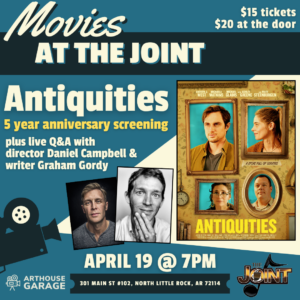
There’s something about the woods that makes them the perfect fit for scary stories. Forests are vast and mysterious and primordial. Just look at a bunch of trees for very long and you can’t help but wonder what sort of things could be happening deep in the woods, miles away from civilization, far away from safety.
The new horror film In the Earth taps into that feeling remarkably well, and takes things a step further by examining the feeling itself. The film is concerned with how humans make meaning out of nature, how we deal with the fear of the unknown, and how we respond to things that are bigger than us and out of our control. Park Ranger Alma (Ellora Torchia) hints at this idea early in the film. She’s talking about the folklore that the locals have created around the nearby woods, which involves an evil spirit that children like to draw pictures of. She says, “The forest is something you can sense… it makes sense to give that feeling a face.”
Writer/director Ben Wheatley carries this idea of humanity’s meaning-making through much of the film, even as he assaults as many of the audience’s senses as he possibly can. The story follows a scientist named Martin Lowery (Joel Fry), who’s attempting to reconnect with an old colleague, Dr. Wendle, who is stationed deep in the woods and has seemingly cut herself off from society. He’s guided through the forest by Alma, a park ranger who has been working in the area for many years. It doesn’t take long before they encounter other people in the woods, and let’s just say things get rough.
That’s all the plot I’ll give to avoid spoilers, but this movie does a lot of things well. Beyond the theme of “man versus nature” mentioned above, we also get the beginnings of some interesting ideas about science and art, and this movie also excels at being truly frightening. Part of the reason for that is the film’s solid cinematography and its better-than-average score, which make for a very moody and creepy atmosphere. The scares also come during the numerous scenes of brutal body horror later in the film; Wheatley is very successful at making you hold your breath and cover your mouth while staring at the screen in horror. For viewers who like that sort of thing (which I do), there’s a lot to like here.
Wheatley also seems to want the film to feel “elemental” in a way. There’s a respect for nature. The opening shot shows a mysterious rock formation, followed by slow-motion closeups of stones being broken apart by repeated hammer blows. That may be symbolic of the beating Wheatley wants to inflict on his audience. Aside from the aforementioned body horror, some incredibly harsh sound design and strobe light effects come later in the film that seem tailor-made to bludgeon the viewer into submission. Again, that’s definitely not for everyone (especially photosensitive viewers), but I do count it as one of the film’s strengths.
Unfortunately, this film really doesn’t stick the landing. All the compelling ideas the screenplay gives us early on don’t amount to much, and the final act, while scary, leaves much to be desired in terms of intellectual stimulation. Things ultimately get very muddled and kind of fizzle out. It feels like a very generic horror ending, which is disappointing after the first two-thirds felt so unique. The script gets decidedly weaker as the film goes on, even to the point that a key character who appears late in the film just isn’t very well-written, spouting exposition in a way that isn’t believable.
There have been a number of “prestige horror” films in recent years that have blended the macabre with strong filmmaking vision and tight screenwriting, but In the Earth doesn’t quite reach those heights. Wheatley is an interesting filmmaker with a diverse body of work, but this will not likely land among his most notable films. If you’re someone who watched Midsommar because of the hype, but a film so horrific was a stretch for you, you should probably stay away from In the Earth. Despite the mention of folklore above, this is quite different from a folk horror film like Midsommar, and actually reminded me more of something like 28 Days Later for its on-edge moodiness and isolated characters. Ultimately, it’s not as good as either of those films though, and while there’s a lot to like about In the Earth, I can really only recommend it to the biggest horror fans out there.
In the Earth is now playing in theaters.






